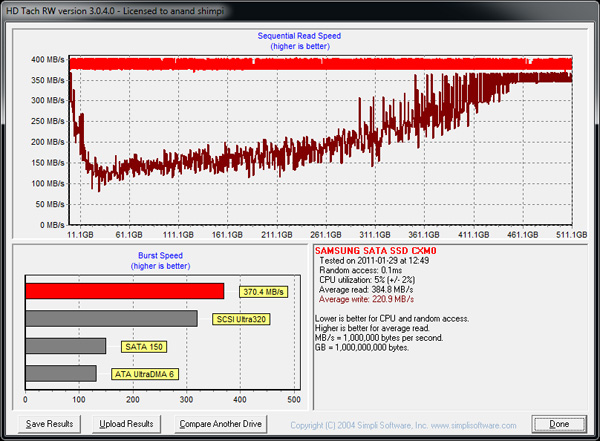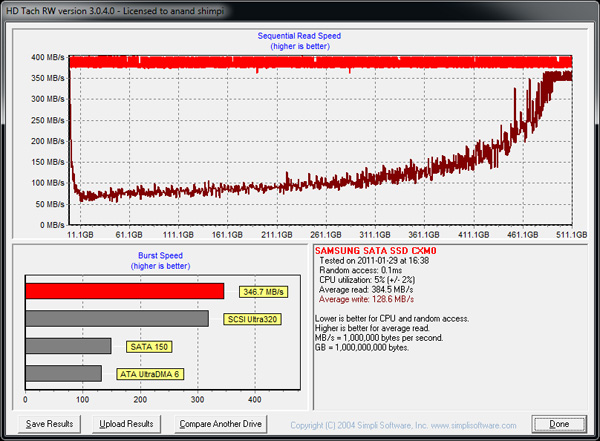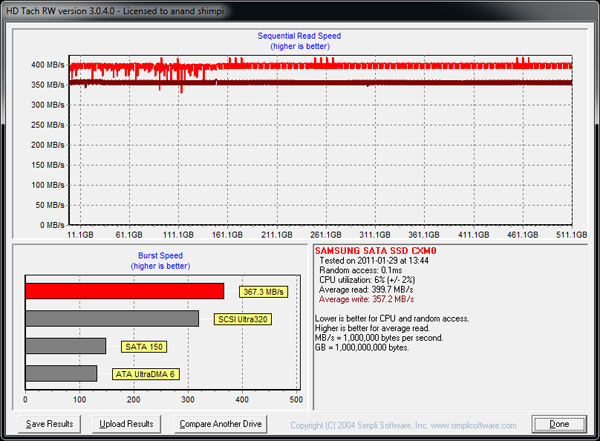The Samsung SSD 830 Review
by Anand Lal Shimpi on September 24, 2011 1:02 AM EST- Posted in
- SSDs
- Storage
- Samsung
- pm830
- Samsung SSD 830
Performance Over Time & TRIM
My biggest issue with Samsung SSDs in the past has been their extremely poor performance over time. Samsung doesn't do a lot of active garbage collection while writing in order to maintain ultra high write speeds, instead it prefers to clean up the drive during periods of little to no IO activity. Unfortunately this approach can result in pretty poor performance over time. In the old days the Samsung controllers would hit single digit write speeds, often slowing down to sub-HDD speeds. These days things are a lot better but it's still a concern. To quantify the behavior I filled all user addressible LBAs on the SSD 830, then proceeded to run our random write torture test on the now-dirty drive. After 20 minutes of torture I ran a single sequential read/write pass to measure how much of a hit the drive took.
Sequential read/write performance should be around 400/330 according to Iometer. Here's what the drive looks like after our torture test:
There's a significant drop in performance but the drive is still able to deliver ~100MB/s speeds. This graph is a bit deceptive however. After 20 minutes of 4KB random writes the SSD 830 will only write at a rate of around 20MB/s. By not doing much realtime garbage collection the random write speed can drop significantly over time, but at a lower write speed the 830 isn't penalized as much as other drives. To help deal with this issue I extended the length of our torture test to 60 minutes and re-ran:
Ah that's a lot more like it. Performance drops significantly, down to as low as 50MB/s for the earliest LBAs. Given enough idle time the 830 should correct much of this and obviously TRIMing those LBAs will restore full performance (as you'll see below) but the point is that by delaying the bulk of garbage collection the Samsung SSD 830 is able to drop in performance by a degree that I'm not super comfortable with. This phenomenon isn't exclusive to Samsung, you'll remember that we've complained about it with Crucial drives as well. Other than SandForce and Intel most controller manufacturers tend to follow a similar clean up the mess later approach to firmware design. In my opinion I'd much rather see lower peak performance and get higher worst case scenario performance as it tends to impact the user experience less.
If you are running under a TRIM enabled OS performance does restore to peak quite nicely after a TRIM pass:













99 Comments
View All Comments
piiman - Saturday, September 24, 2011 - link
Might have something to do with Apple's and Samsungs legal issues. They seem to be trying to kill each other at the moment and having your supply line coming from someone you are suing and being sued by, isn't a good idea. Has soon as those supply contracts are up Samsung may tell them to kiss their $%@#lyeoh - Sunday, September 25, 2011 - link
It's probably less of "killing each other" and more of haggling and "poker" between the two.By diversifying Apple can say to Samsung, "Go ahead, make my day".
Havor - Saturday, September 24, 2011 - link
Wit most SSDs the size realy matters, why not just format a drive in to different size partitions.Format one partition to 120GB and fill the other 392GB partition up data so it cant be used for trim or any other optimizing benefits.
Because I am sick and tired of these firms sending big SSDs that dont represent real world use, as I will never buy a +$700 512GB drive, the sweets spot for most people is around 120/128GB.
I wane know how a 120/128GB drive preforms not a model that's way above my budget.
akedia - Saturday, September 24, 2011 - link
Partitioning wouldn't affect the number of channels, which does affect performance quite a lot, so you'd end up with numbers that reflect no actual product at all.juhatus - Saturday, September 24, 2011 - link
With Samsung's budget on these..EMC is using Samsung drive's in their enterprise storage products (Clariion) and they are the same sata drive's, except different stamp.
If its good enough for the enterprise-class serious work than it sure is good enough for consumers.
When's the availability for consumers?
jwcalla - Saturday, September 24, 2011 - link
It seems that every SSD article I read on AnandTech ends with a plug for an Intel drive. I understand some of the logic there, but it's not like Intel has an unblemished reliability record. The 320 fiasco was just as bad as anything we saw with the Corsair or SandForce drives. And IMO the price premium of the Intel 510 weighs heavily against it in comparison to, say, the m4 or Samsung options.Fun Guy - Monday, September 26, 2011 - link
Agreed - the reviews at New Egg show Crucial to be top dog, with Intel somewhere near the middle.JarredWalton - Monday, September 26, 2011 - link
I can't take Newegg reviews seriously, though: "I bought this product with my own money, so now I have to praise it to avoid buyer's remorse." Sure, there are bad reviews and good reviews out there, but even taking the average review score at Newegg isn't as useful as a real review looking at benchmarks and comparing with other drives.Crucial is one of the cheapest SSDs and still offers good performance, which is what most Newegg shoppers are after. Intel on the other hand charges a price premium, which is precisely what Newegg shoppers don't like. Outside of the 320 "fiasco" (which is something we warn about with every new SSD), Intel SSDs have proven very reliable over time, particularly compared with their contemporaries. The G1 no-TRIM thing was Intel being greedy, but G1 still worked quite well for the vast majority of users (even if it could get backed into a corner where performance would tank). G2 wasn't the fastest in its day, but it was fast enough and rarely gets into the poor performance realm.
Ultimately, if I'm putting my data on a device, I want it to be long-term reliable. So, I'm not buying any brand-new SSD or HDD. I let it stew for a couple months at least and then see if there are any issues cropping up. That gets you around things like SF-2200 issues, Intel 320, etc.
Oxford Guy - Friday, August 17, 2012 - link
"The G1 no-TRIM thing was Intel being greedy, but G1 still worked quite well for the vast majority of users (even if it could get backed into a corner where performance would tank)."In other words, it was a reliability issue because the vendor could not be relied upon to do the right thing.
elerick - Saturday, September 24, 2011 - link
Anand you used a Intel h67 in your test bed and I am currently run a 990FX chipset. Due to budget I'm looking for a good 120GB SSD(OS drive), what would you recommend? Also I cant wait if there is something around the corner.